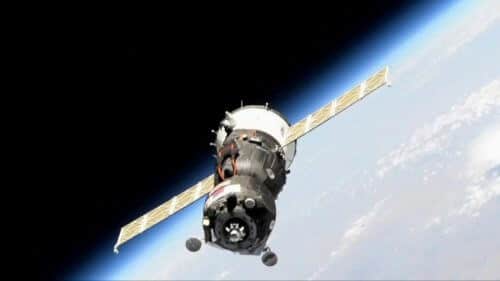The docking attempt on Saturday was aborted after the Russians suspected that there was a malfunction in the automatic rendezvous system of the Foysk airlock at the space station. NASA emphasizes that at no point was there any risk to the six members of the station's crew

(update to 28/8/19: the maneuver was successfully performed and the Soyuz is connected to the space station)
The Soyuz MS-14 spacecraft that normally flies astronauts to the space station but this time was launched unmanned failed its attempt to dock with the International Space Station on Saturday. International Space Station program managers at NASA and the Russian Space Agency informed the astronauts that another docking attempt will take place on Monday at 22:10 PM EST (Tuesday 05:10 Israel time).
The docking attempt was aborted after the Russians suspected that there was a malfunction in the automatic rendezvous system of the Foisk airlock at the space station. NASA emphasizes that at no point was there any risk to the six members of the station's crew.
Usually Soyuz spacecraft arriving at the station are manned by three crew members who replace three others, but this time there were no passengers on board, except for a robot intended for experiments on the space station. The purpose of the mission was to try improvements to the escape system for the Soyuz-2.1a launcher (even though it's confusing - both the launcher and the spacecraft on it are called Soyuz AB).
Soyuz MS-14 was launched on August 22, 2019 from the Baikonur Space Center in Kazakhstan, and was the first unmanned Soyuz spacecraft in 33 years, and the first unmanned Soyuz ever launched to the space station.
The Soyuz capsule is now orbiting Earth at a safe distance from the International Space Station with all its systems operating normally.
Transferring a spaceship from one berth to another
On Monday at 60:13 a.m., a connection attempt will be made again, this time to the airlock of the Zvzda module on the space station, which was tested and found to be working. To carry out the new plan, members of the XNUMXth Alexander Expedition crew, Roscosmos' Yeato Skvortov, the European Space Agency's Luca Parmitano, and NASA's Drew Morgan, will board the spacesuits in their Soyuz MS-XNUMX, and transport it by shuttle to Foysk, thus overcoming the glitch which, as mentioned, prevents the automatic docking of spacecraft in the Puisak component.
By the way, the next day, SpaceX's Dragon cargo spaceship, which brought cargo to the station and was attached to it for a month (with an American component), is supposed to leave the station. The spaceship will return to Earth, deploy parachutes and land in the Pacific Ocean, with cargo and scientific experiments to be returned from the space station.

5 תגובות
Foysk is the name of this particular part of the space station.
Today she succeeded
All because of the Poisk air lock...
Only I would love to understand what it is... From a lock I can guess, but Puisak? Is this a Russian word? What did I miss??
Thanks for the comment and the compliments.
Beautiful and interesting article.
Note - adding the initials of the author's name at the end of what is given in parentheses is required when it comes to a quote and inside parentheses with an explanation outside the quote. According to an explanation in parentheses in the middle of the article, there is no need for this